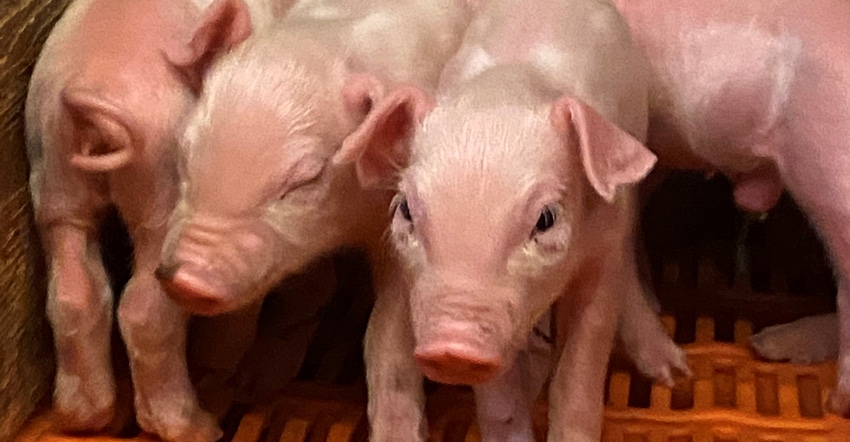
Pork production in Minnesota is big business.
The state is the second-largest hog producer behind first-place Iowa. Roughly, 3,500 hog farms in Minnesota sold 22.3 million hogs in 2019, earning $2.7 billion in hog sales. On average, each hog farm in the state generates $1.5 million in economic activity.
Given what the pork industry is going through with major supply chain disruptions due to COVID-19, three University of Minnesota Extension scientists wondered what the impact would be on hog farms and their rural communities.
Assuming a 15% drop in hog production, similar to the 15% unemployment rate experienced in other industries, the Extension scientists’ model estimated a loss of $660 million in economic activity in rural Minnesota.
The scientists also found a 15% drop in hog production would lead to an estimated loss of 2,100 jobs.
Co-authors of the report were Brigid Tuck, Extension senior economic impact analyst, Extension economist Joleen Hadrich and Extension educator Megan Roberts.
“The hog industry, like so many industries, is facing an unprecedented crisis during COVID-19,” Roberts says. “Hog farmers are an important part of the Minnesota economy and an important factor in the health of main street in many rural communities. Joleen, Brigid and I wanted to quantify the economic contribution of hog farms to help consumers and community leaders understand the importance of this industry.”
During the last week of April there was no market for approximately 45% of Minnesota’s hogs due to widespread closures and partial closures of processing plants, according to the report. Future resumption of processing and butchering alternatives will help offset some of the losses, but repercussions are expected to continue.
Losses mount for hog farmers
While hog farmers generate considerable economic activity, in recent years they made little profit or lost money, the Extension report noted. On average, Minnesota farmers lost 32 cents per animal in 2019. The average hog farm in Minnesota markets just over 6,000 head per year.
And unfortunately, farm number attrition is not anything new. According to the 2007 U.S. Census, Minnesota had 4,748 hog farms. The 2017 census data showed numbers dropped to 3,562—a 25% reduction.
The 2020 outlook is challenging, at best, especially for independent farmers who own and raise their own livestock.
“Between March and May, hog prices plunged 26%, from 50 cents per pound pre-COVID-19 to 37 cents in early May,” according to Roberts, who farms with her husband and his family in Blue Earth County. They raise corn, beans and independently farrow-to-finish hogs with a 600-sow herd.
“We have been lucky to continue marketing our hogs at the same numbers during the past few months as we had been pre-COVID19,” she says.
After sending a load of pigs during peak of plant closures in late April, Roberts says she felt an immense feeling of relief as the semi-truck left the yard.
“It was and is a very stressful time,” she says. “We know so many other families that have not been able to get their hogs to market. When I conduct research, I like to remind people there are real farm families and rural communities behind the statistics.”
At the time she worked on the report, Roberts says she was comparing federally inspected hog plant capacity in late February to late April. Back then, capacity for hog slaughter had been reduced by 45%, meaning that hog farmers were facing 55% of normal capacity. By May 21, Agricultural Marketing Service Report data showed federally inspected capacity was closer to 75%. By early June, it had inched to 80%.
Still, with how tightly hog supplies are aligned and contracted for marketing, even operating at 80% plant capacity isn’t enough to help hog farmers, according to Dave Preisler, Minnesota Pork Producers CEO.
“Eighty percent won’t keep us from euthanizing pigs,” he says.
Seek assistance
Preisler encourages farmers to contact their FSA offices to find out about hog payments available through the federal emergency COVID payment program. However, depending on when hog producers euthanized pigs, they may or may not receive a payment.
“If a farmer put down pigs between April 16 to May 14, they could count those pigs as inventory and get a small payment,” he says. “After May 14, nothing.”
Lawmakers have discussed indemnity payments for hog farmers, but nothing has been passed yet.
Hog farmers across the state are in various stages of financial and marketing stress, he says.
“Each farmer is in a different spot in Minnesota,” Preisler says. “It depends on what they had to market and what packer they are working with.”
About half the pigs in Minnesota leave the state for processing, heading for Iowa, South Dakota, Nebraska and Missouri. Around 1,000 farmers in the state are independent growers who raise and sell their own pigs, Preisler says, and the remaining are contract growers.
All hog farmers have the same concerns these days, though: packing plant capacity, market prices and business finances.
The report authors offered some suggestions that may help hog farming industry at this time. Those include:
For farmers, exploring different marketing options that allow farms to get as close to breaking even as possible.
For rural communities, understanding how the agricultural economy functions and the challenges facing producers.
For consumers, making reasonable amounts of meat purchases that last one to two weeks to help stabilize the meat supply chain or buying meat at local meat markets.
The full report is available to read online.
For online Extension resources on financial stress and mental health, visit z.umn.edu/ruralstress.
Read more about:
Covid 19About the Author(s)
You May Also Like






